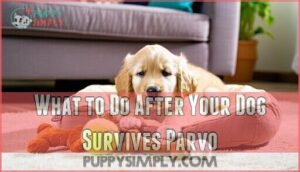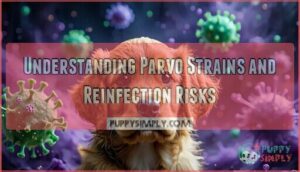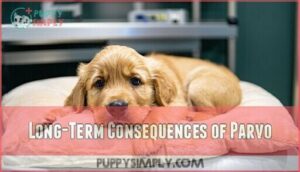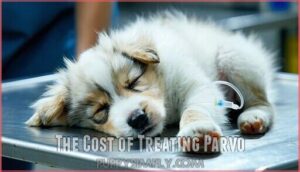This site is supported by our readers. We may earn a commission, at no cost to you, if you purchase through links.
 Yes, a dog can get parvo twice, but it’s about as common as finding a four-leaf clover in your backyard.
Yes, a dog can get parvo twice, but it’s about as common as finding a four-leaf clover in your backyard.
Dogs who survive parvovirus usually develop strong immunity that lasts for years, making reinfection extremely rare.
However, dogs with weakened immune systems, those exposed to different viral strains, or pups who didn’t fully recover initially might face round two.
Think of it like chicken pox in humans – once you’ve had it, you’re typically protected, and your best defense remains vaccination and proper care during recovery.
What many pet owners don’t realize is that certain factors can actually increase reinfection risks.
Table Of Contents
- Key Takeaways
- How Does Parvo Affect Dogs?
- Recognizing Symptoms of Parvo
- Treatment Options for Parvo
- What to Do After Your Dog Survives Parvo
- Understanding Parvo Strains and Reinfection Risks
- Long-Term Consequences of Parvo
- The Cost of Treating Parvo
- Preventing Parvo in Other Dogs
- Recovery Expectations for Dogs With Parvo
- Can a Dog Get Parvo Twice?
- Frequently Asked Questions (FAQs)
- What are the odds of a dog getting parvo twice?
- Can a dog get parvo after having parvo?
- Why does my dog keep getting parvo?
- What to do after your dog survived parvo?
- How long after exposure do symptoms appear?
- What disinfectants kill parvo effectively?
- Is there a vaccine for the new strains of parvo?
- How do I comfort my dog while he’s sick with parvo?
- How long does parvo immunity last?
- Can vaccinated dogs still get parvo?
- Conclusion
Key Takeaways
- Your dog can technically get parvo twice, but it’s extremely rare—only about 0.001% of recovered dogs experience reinfection, making it about as likely as finding a four-leaf clover.
- Once your dog survives parvo, they’ll typically develop strong immunity that lasts for years or even their entire lifetime, providing excellent protection against future infections.
- You should still watch for reinfection risks in dogs with weakened immune systems, incomplete vaccinations, or exposure to mutated viral strains that might challenge existing immunity.
- Prevention through proper vaccination remains your best defense—completing the full puppy vaccination series and maintaining adult boosters protects against all circulating parvo strains more effectively than relying on natural immunity alone.
How Does Parvo Affect Dogs?
Parvovirus hits your dog’s digestive system like a wrecking ball, attacking intestinal walls and bone marrow with devastating precision.
Parvo strikes like lightning—devastating your pup’s gut and immune system with ruthless, life-threatening speed.
This parvo pathophysiology creates severe intestinal damage, leading to bloody diarrhea, vomiting, and rapid dehydration.
Your pup’s immune response becomes compromised as the virus destroys infection-fighting white blood cells, and puppy susceptibility peaks between 6-20 weeks when maternal antibodies fade.
Certain breeds show breed predisposition, with Rottweilers and Pit Bulls facing higher risks, and without swift treatment, this aggressive virus can prove fatal within days.
Recognizing Symptoms of Parvo
Three days after exposure, your dog’s world can turn upside down.
Your pup’s appetite vanishes overnight—they won’t even glance at their favorite bacon treats.
Early Parvo Signs hit fast—watch for Symptom Progression Speed that escalates within hours.
Distinguishing Parvo from typical stomach bugs requires recognizing these Severity Indicators:
- Explosive, bloody diarrhea with a distinctive metallic smell
- Projectile vomiting that won’t stop despite an empty stomach
- Complete loss of appetite—they won’t even sniff their favorite treats
- Lethargy so severe your pup can barely lift their head
- Fever followed by dangerously low body temperature
- Severe dehydration causing sunken eyes and sticky gums
Puppy-Specific Symptoms often include weakness and collapse.
These gastrointestinal symptoms demand immediate veterinary attention—parvo reinfection symptoms mirror initial infections exactly.
Treatment Options for Parvo
When your dog shows parvo symptoms, immediate veterinary care becomes critical.
Parvo treatment centers on supportive care since no cure exists. Fluid therapy combats severe dehydration while antibiotic use prevents secondary infections.
Advanced parvo veterinary care may include plasma transfusions and antiviral medications for severe cases. Nutritional support helps maintain strength during recovery.
With proper parvo reinfection treatment protocols, survival rates reach 90% when caught early. Understanding typical parvo expenses can help owners prepare for the financial commitment.
Your vet will monitor essential signs, manage pain, and provide round-the-clock nursing care until your pup stabilizes.
What to Do After Your Dog Survives Parvo
Recovery brings relief, but your dog’s healing journey isn’t over yet. Parvo recovery requires careful attention to help your pup regain full strength and prevent complications.
Diet adjustments start with small, frequent meals using easily digestible food. Your vet might recommend a bland diet initially before gradually returning to regular kibble. Exercise resumption should be gradual – short walks are fine, but avoid strenuous activity for several weeks.
Watch for behavioral changes that might signal lingering issues. Some dogs experience temporary digestive sensitivity or fatigue. Monitoring health means tracking appetite, energy levels, and bathroom habits closely.
Continued care includes finishing all prescribed medications, even if your dog seems completely recovered. Follow-up vet visits confirm proper healing and address any concerns.
- Schedule a follow-up appointment within 1-2 weeks to confirm your dog’s complete recovery and discuss long-term health monitoring.
Most dogs bounce back completely with proper aftercare, building strong parvo immunity that typically lasts a lifetime.
Understanding Parvo Strains and Reinfection Risks
You might wonder if your dog can catch parvo again after surviving it once, and the answer involves understanding different virus strains and how your pet’s immune system responds.
While reinfection is extremely rare, affecting only about 0.001% of recovered dogs, certain factors like mutated strains and weakened immunity can slightly increase this risk, particularly due to mutated strains.
Immunity Levels and Reinfection
After surviving parvo, your dog’s natural immunity typically provides strong protection for about three years.
However, antibody duration varies between individual dogs, and immune response strength affects re-infection rates.
While parvo reinfection remains extremely rare—occurring in less than 0.001% of recovered dogs—strain variations can occasionally challenge existing immunity.
Most dogs won’t get parvo a second time. Recovered dogs typically develop lifelong parvo immunity, making recurrence highly unlikely.
Mutating Parvo Strains
Like a master of disguise, parvo keeps reinventing itself through genetic mutations that create new strain variations.
Your dog’s immunity from surviving one infection mightn’t recognize these emerging strains. The virus causes acute gastrointestinal illness in affected puppies.
- Mutation impact creates parvo variant strains with different properties
- Cross-protection isn’t guaranteed against mutated strains
- Diagnostic challenges arise when identifying new variants
- Parvo recurrence becomes possible despite previous recovery
This ongoing evolution makes parvo reinfection a real concern for pet owners.
Cardiac Risks and Immunity
Beyond the gut, parvo can sneak into your dog’s heart, causing myocarditis effects that demand attention.
Heart complications from parvo reinfection remain rare, but cardiac monitoring helps catch issues early.
While parvo immunity dogs develop typically lasts years, the parvo reinfection rate stays extremely low at 0.001%.
Regular check-ups are essential for ongoing dog health.
| Cardiac Risk Factor | Impact Level |
|---|---|
| Puppies under 3 months | High (70% mortality) |
| Adult dogs | Low risk |
| Vaccinated dogs | Protected |
| Immune-compromised | Moderate risk |
Long-Term Consequences of Parvo
Parvo doesn’t just disappear after recovery—it can leave lasting marks on your dog’s health.
Your pup faces a 5.33 times higher risk of chronic digestive problems, with compromised gut health affecting nutrient absorption for years.
The immune system often stays weakened, making dogs more vulnerable to future infections.
Some experience cardiac issues or neurological effects, while puppies may suffer growth stunting.
Though parvo reinfection is rare due to strong parvo immunity dogs develop, monitoring your pet’s long-term health remains critical for detecting any lingering consequences.
Long-term health monitoring can also help to identify common pet issues early.
The Cost of Treating Parvo
Treating parvo hits your wallet hard. Treatment expenses for hospitalization costs can drain your savings faster than you’d expect.
Here’s what you’re looking at:
- Emergency veterinary care – $1,500-$3,000 per day
- IV fluids and medication pricing – $400-$800 total
- Blood tests and diagnostics – $200-$500
- Antibiotics and anti-nausea drugs – $150-$300
- Follow-up appointments – $100-$250
- Financial assistance programs – Available through some clinics
Preventative savings through vaccination beats these crushing bills. Smart owners invest in prevention rather than face parvo’s devastating survival rate statistics.
Preventing Parvo in Other Dogs
Since parvo spreads like wildfire and can survive on surfaces for years, you’ll need to take swift action to protect other dogs in your home and neighborhood.
Think of it as creating a protective bubble around healthy pups while your infected dog recovers and stops shedding the virus.
Isolation and Disinfection
Once you’ve tackled the financial burden of parvo treatment, protecting your other pets becomes the next priority.
Quarantine protocols start immediately – your infected dog needs complete isolation from healthy pets in a separate room or area.
Surface disinfection requires serious attention since parvo survives on contaminated surfaces for months.
Safe disinfectants like a 1:30 bleach solution effectively kill the virus when you follow label directions exactly.
Scrub every surface your sick pup touched – floors, food bowls, toys, and outdoor areas.
You can find a parvo disinfectant spray for effective cleaning.
Handling waste demands protective gear.
Wear disposable gloves when cleaning up vomit or diarrhea, and double-bag all contaminated materials.
Your shoes can transport the virus between rooms, so consider disposable shoe covers or dedicated "sick dog" footwear.
Preventing spread means thorough disinfection methods until your vet confirms your dog’s no longer contagious.
This aggressive parvo disinfection approach protects your entire furry family from this devastating disease.
Vaccination Recommendations
Three vaccination steps protect your dog from parvo’s devastating effects. First, start puppy vaccinations between 6-8 weeks, following the vaccination schedule with booster shots every 2-4 weeks until 16 weeks old. Maternal antibodies fade during this critical period, making consistent timing essential.
Second, give adult dogs their first booster one year after completing the initial series, then every three years thereafter. Third, immediately vaccinate any unprotected dogs in your household after exposure.
You can find a parvo dog vaccine through various retailers.
Here’s your vaccination roadmap:
- Puppy series: Three core shots spaced 2-4 weeks apart
- Adult booster: Annual shot, then every three years
- Emergency protocol: Immediate vaccination for exposed, unprotected dogs
Vaccine efficacy depends on completing the full series—parvo vaccine failure often stems from incomplete schedules or parvo waning immunity over time.
Recovery Expectations for Dogs With Parvo
After protecting other dogs from exposure, you’ll want to know what lies ahead for your recovering pup.
Most dogs bounce back within 5-10 days with proper care, though the recovery timeline varies by individual case and parvo survival factors.
Your dog’s appetite should return within a week, while energy levels gradually improve.
Watch for potential complications like lingering digestive issues that might affect their quality of life long-term.
| Recovery Stage | What to Expect |
|---|---|
| Days 1-3 | Gradual reduction in vomiting/diarrhea |
| Days 4-7 | Appetite returns, increased activity |
| Week 2+ | Normal energy, occasional loose stools |
Can a Dog Get Parvo Twice?
While your dog’s recovery is encouraging, you’re probably wondering about dog parvo reinfection risks.
The good news is that parvo recurrence is extremely rare, and most dogs develop strong immunity lasting years after their first infection.
However, parvo second time infections can occur due to strain variations or genetic predisposition in certain breeds, and environmental risks from contaminated surfaces also pose threats.
Studies show that only 0.001% of dogs experience parvo breakthrough infection, and your pup’s immunity duration typically provides lifelong protection, making reinfection likelihood minimal with proper care.
Frequently Asked Questions (FAQs)
What are the odds of a dog getting parvo twice?
Lightning rarely strikes the same spot twice, and parvo reinfection follows similar odds.
Your dog’s chances of getting parvo twice are extremely rare—roughly 001%.
Natural immunity from surviving parvo typically protects them for life.
Can a dog get parvo after having parvo?
Yes, your dog can technically get parvo again after recovering, but it’s extremely rare. Natural immunity from surviving parvo typically lasts for years, with only about 001% of dogs experiencing reinfection.
Why does my dog keep getting parvo?
Multiple parvo infections strike like lightning in a bottle – extremely rare but possible.
You’re likely seeing different strains, incomplete vaccination, or immune system issues.
Consult your vet immediately to identify the underlying cause, and consider the possibility of incomplete vaccination.
What to do after your dog survived parvo?
Focus on gradual recovery with bland foods, probiotics, and plenty of rest.
Schedule follow-up vet visits to monitor healing.
Keep vaccinations current and maintain good hygiene to prevent reinfection, though immunity typically lasts years with probiotics.
How long after exposure do symptoms appear?
Parvo’s sneaky arrival typically shows up three to ten days after your pup encounters the virus.
You’ll notice the telltale signs—vomiting, diarrhea, lethargy—within this window, though some dogs develop symptoms sooner.
What disinfectants kill parvo effectively?
Bleach solutions (1:32 ratio), Accelerated Hydrogen Peroxide, and Potassium Peroxymonosulfate effectively kill parvovirus.
Regular household cleaners won’t work since parvo’s incredibly tough.
You’ll need these specific disinfectants to truly eliminate the virus from surfaces.
Is there a vaccine for the new strains of parvo?
Yes, current vaccines protect against new parvo strains.
The DHPP vaccine covers all circulating variants, including CPV-2a, 2b, and 2c.
You don’t need separate shots since cross-immunity works across strains.
How do I comfort my dog while he’s sick with parvo?
Keep your pup hydrated with small water sips, provide a quiet comfortable space, offer gentle belly rubs, and stay close for reassurance. Your presence means everything during this tough time.
How long does parvo immunity last?
Unlike fleeting seasonal immunity, your dog’s parvo protection runs deep.
After surviving infection or completing vaccination, immunity typically lasts their entire lifetime—often 10-15 years or more with strong antibody levels, providing lifetime protection.
Can vaccinated dogs still get parvo?
Vaccinated dogs can still contract parvo, though it’s uncommon. Vaccines aren’t 100% foolproof, especially against new strains or if your dog’s vaccination series was incomplete or their immune system is compromised.
Conclusion
Like lightning rarely striking the same place twice, reinfection remains uncommon when dogs develop proper immunity after surviving their first bout.
While the answer to "can a dog get parvo twice" is technically yes, most recovered dogs enjoy years of proper immunity.
Your best strategy involves maintaining vaccination schedules, monitoring immune-compromised pets closely, and ensuring complete recovery before exposure risks.
Remember, prevention through vaccination beats treating this devastating disease twice, so stay vigilant, keep vaccines current, and trust your vet’s guidance for maximum protection.
- https://pubmed.ncbi.nlm.nih.gov/3003015/
- https://pangovet.com/?utm_source=dogster&utm_medium=article&utm_campaign=dog_infection_illness
- https://www.avma.org/news/canine-parvovirus-treatment-receives-conditional-approval
- https://www.sciencedirect.com/science/article/pii/S0378113506001489
- https://www.aaha.org/resources/2022-aaha-canine-vaccination-guidelines/












